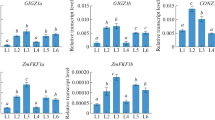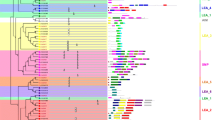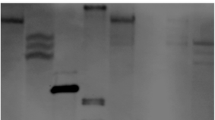Abstract
A Zea mays cDNA clone, ZmERabp4, coding for a new member of the auxin-binding protein family was isolated. The primary amino acid sequence contains an N-terminal hydrophobic leader sequence, a potential glycosylation site (Asn136-Thr-Thr) and a C-terminal KDEL motif known to be responsible for retention of proteins within the lumen of the ER. The expression pattern of the ZmERabp4 gene in various organs of maize differs from the expression pattern previously observed for the ZmERabp1 gene. The ZmERabp4 gene is expressed highly in male flower organs, whereas the ZmERabp1 gene shows highest expression in female flower parts. In situ hybridization and analysis by laser scanning microscopy revealed enhanced levels of expression for both genes in the coleoptile when compared with the primary leaf of etiolated maize seedlings.
Similar content being viewed by others
References
Angerer LM, Cox KH, Angerer RC: Demonstration of tissue-specific gene expression by in situ hybridisation. In: Berger SL and Kimmel AR (eds) Methods in Enzymology, vol. 152, pp. 649–661. Academic Press, San Diego, CA (1987).
Ausubel FM, Brent R, Kingston RE, Moore DD, Seidman JG, Smith JA, Struhl K (eds): Current Protocols in Molecular Biology. Green Publishing Associates/Wiley Interscience, New York (1989).
Barbier-Brygoo H, Ephritikhine G, Klämbt D, Ghislain M, Guern J: Functional evidence for an auxin receptor at the plasmalemma of tobacco mesophyll protoplasts. Proc Natl Acad Sci USA 86: 891–895 (1989).
Barbier-Brygoo H, Ephritikhine G, Klämbt D, Maurel C, Palme K, Schell J, Guern J: Perception of the auxin signal at the plasma membrane of tobacco mesophyll protoplasts. Plant J 1: 83–93 (1991).
Bedbrook J: A plant nuclear DNA preparation procedure. Plant Mol Biol Newsl 2: 24 (1981).
Chomczynski P, Sacchi N: Single-step method of RNA isolation by acid guanidinium thiocyanate-phenol-chloroform extraction. Anal Biochem 162: 156–159 (1987).
Hertel R, Thomson KS, Russo VEA: In vitro auxin binding to particulate cell fractions from corn coleoptiles. Planta 107: 325–340 (1972).
Hesse T, Feldwisch J, Balshüsemann D, Bauw G, Puype M, Vandekerckhove J, Löbler M, Klämbt D, Schell J, Palme K: Molecular cloning and structural analysis of a gene from Zea mays (L.) coding for a putative receptor for the plant hormone auxin. EMBO J 8: 2453–2461 (1989).
Jones AM, Lamerson PM, Venis MA: Comparison of site I auxin binding and a 22-kilodalton auxin-binding protein in maize. Planta 179: 409–413 (1989).
Jones AM, Cochran DS, Lamerson PM, Evans ML, Cohen JD: Red light-regulated growth. I. Changes in the abundance of indoleacetic acid and a 22 kilodalton auxin-binding protein in the maize mesocotyl. Plant Physiol 97: 352–358 (1991).
Jones AM, Prasad PV: Auxin-binding proteins and their possible roles in auxin-mediated plant cell growth. BioEssays 14: 43–48 (1992).
Kozak M: The scanning model for translation: an update. J Cell Biol 108: 229–241 (1989).
Kreimer G, Melkonian M: Reflection confocal laser scanning microscopy of eyespots in flagellated green algae. Eur J Cell Biol 53: 101–111 (1990).
Lütcke HA, Chew KC, Mickel FS, Moss KA, Kern HF, Scheele GA: Selection of AUG initiation codons differs in plants and animals. EMBO J 6: 43–48 (1987).
Maniatis T, Fritsch EF, Sambrook J: Molecular Cloning: A Laboratory Manual, vol. I–III. Cold Spring Harbor Laboratory Press, Cold Spring Harbor, NY (1989).
Pelham HRB: The retention signal for the soluble proteins of the endoplasmic reticulum. Trends Biochem Sci 15: 483–486 (1990).
Prasad PV, Jones AM: Putative receptor for the plant growth hormone auxin identified and characterized by anti-idiotypic antibodies. Proc Natl Acad Sci USA 88: 5479–5483 (1992).
Ray PM, Dohrmann U, Hertel R: Specificity of auxin-binding sites on maize coleoptile membranes as possible receptor sites of auxin action. Plant Physiol 60: 585–591 (1977).
Rück A, Palme K, Venis MA, Napier R, Felle HH: Patch-clamp analysis establishes a role for an auxin-binding protein in the auxin stimulation of plasma current in Zea mays protoplasts. Plant J 4: 41–46 (1993).
Shimomura S, Sotobayashi T, Futai M, Fukui T: Purification and properties of an auxin-binding protein from maize shoot membranes. J Biochem 99: 1513–1524 (1986).
Venis MA, Napier RM, Barbier-Brygoo H, Maurel C, Perrot-Rechenmann C, Guern J: Antibodies to a peptide from the maize auxin-binding protein have auxin agonist activity. Proc Natl Acad Sci USA 89: 7208–7212 (1992).
VonHeijne G: Patterns of amino acids near signal-sequence cleavage sites. Eur J Biochem 133: 17–21 (1983).
Walton DJ, Ray P: Evidence for receptor functions of auxin-binding sites in maize. Plant Physiol 68: 1334–1338 (1981).
Author information
Authors and Affiliations
Rights and permissions
About this article
Cite this article
Hesse, T., Garbers, C., Brzobohaty, B. et al. Two members of the ERabp gene family are expressed differentially in reproductive organs but to similar levels in the coleoptile of maize. Plant Mol Biol 23, 57–66 (1993). https://doi.org/10.1007/BF00021419
Received:
Accepted:
Issue Date:
DOI: https://doi.org/10.1007/BF00021419




